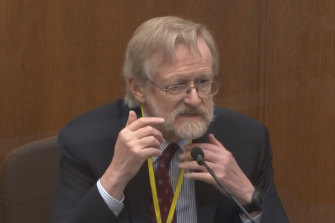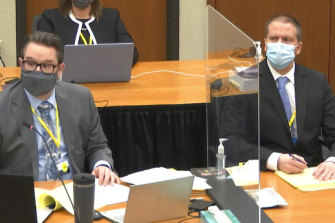Minneapolis: George Floyd died of a lack of oxygen from being pinned on his stomach with his hands cuffed behind him and his face jammed against the pavement, a medical expert has testified at former officer Derek Chauvin’s murder trial.
Floyd’s breathing while he was being held down by Chauvin and two other officers was too shallow to take in enough oxygen, which in turn damaged his brain and caused his heart to stop, said Dr Martin Tobin, a lung and critical care specialist at the Edward Hines, Jr VA Hospital and Loyola University’s medical school in Chicago.
Dr Martin Tobin testifies at Derek Chauvin’s murder trial.Credit:AP
Tobin was called to testify on Thursday, local time, as part of an effort by prosecutors to establish that it was Chauvin’s actions – not Floyd’s illegal drug use and underlying health conditions, as the defence contends – that killed the 46-year-old black man last May.
Tobin took direct aim at the defence theory, declaring: “A healthy person subjected to what Mr Floyd was subjected to would have died as a result of what he was subjected to.”
Chauvin kept his knee on Floyd’s neck for 3 minutes, 2 seconds, after Floyd had “reached the point where there was not one ounce of oxygen left in the body,” Tobin said.
The witness cited several factors that he said had made it difficult for Floyd to breathe, beyond Chauvin’s knee on his neck: officers lifting up on his handcuffs, the hard street, his prone position, his turned head, and a knee on his back.
Tobin, analysing a graphic presentation of the three officers pinning Floyd for what prosecutors say was almost 9½ minutes, said Chauvin’s knee was “virtually on the neck for the vast majority of time”. He said it was “more than 90 per cent of the time in my calculations”.
Defence attorney Eric Nelson, left, and defendant former Minneapolis police Officer Derek Chauvin.Credit:AP
He said it appeared that Floyd was getting enough oxygen for about the first five minutes to keep his brain alive because he was still speaking.
But Tobin said where Chauvin had his knee after the five-minute mark would not make much of a difference, because at that point, Floyd had already experienced brain damage.
Chauvin attorney Eric Nelson has repeatedly shown the jury still images from the video that he said showed Chauvin’s knee was on Floyd’s shoulder blade. But nearly all of those images were captured more than five minutes into the ordeal, according to video time stamps.
Tobin explained to jurors what happens as the space in the airway narrows, saying breathing then becomes “enormously more difficult,” like “breathing through a drinking straw”.
Tobin testified that if the hypopharynx – the bottom part of the throat – becomes totally obstructed, it takes just seconds to reduce the level of oxygen to where it would result “in either a seizure or a heart attack”.
Prosecutors showed images of Floyd side by side, one with the front of his face pressed against the pavement and another with his head turned. Tobin said that when Floyd’s head was facedown, a ligament at the back of his neck would have protected his airway. But with his head turned, Chauvin’s weight would have compressed the hypopharynx.
The expert calculated that at times when Chauvin was in a near-vertical position, with his toes off the ground, half of Chauvin’s body weight – 41.5 kilograms – was directly on Floyd’s neck.
Tobin used simple language, with terms like “pump handle” and “bucket handle” to describe the act of breathing for jurors. At one point, he invited them to “examine your own necks, all of you in the jury right now” to better understand the effect of a knee on a person’s neck.
Most of the jurors felt their necks as Tobin instructed, though the judge later told them they didn’t have to do so.
Chauvin, 45, is charged with murder and manslaughter in Floyd’s death on May 25. Floyd was arrested outside a neighbourhood market after being accused of trying to pass a counterfeit $20 bill. A panicky-sounding Floyd struggled and claimed to be claustrophobic as police tried to put him in a squad car, and they pinned him to the pavement.
Bystander video of Floyd crying that he couldn’t breathe as onlookers yelled at Chauvin to get off him sparked protests and scattered violence around the US.
Nelson has argued that the now-fired white officer “did exactly what he had been trained to do over his 19-year career,” and he has disputed that Chauvin’s actions were what killed Floyd. Fentanyl and methamphetamine were found in Floyd’s system.
AP
What in the World
A note direct from our foreign correspondents about what’s making headlines around the world. Sign up for our weekly newsletter here.
Most Viewed in World
From our partners
Source: Read Full Article




